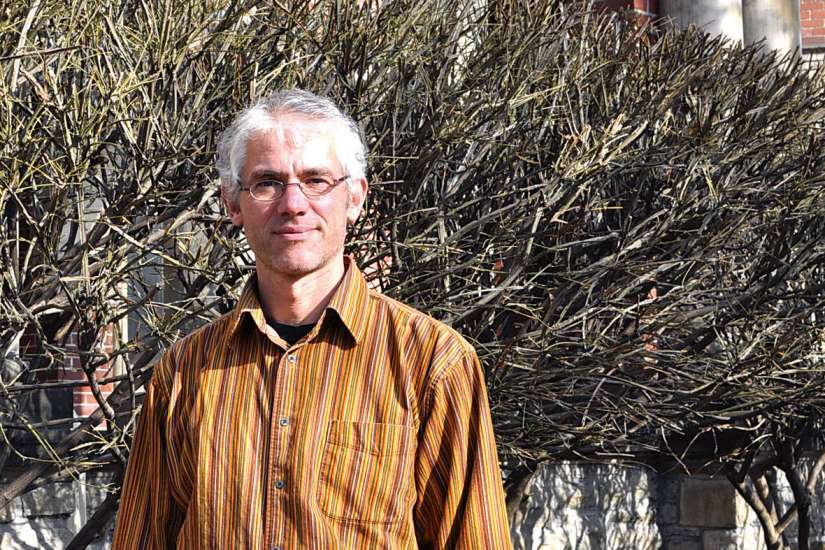Trained in contemporary dance since the age of 19, Waille has more than 27 years of experience as an artist and teacher. The French academic is one of the leading experts on the history and method of François Delsarte, an influential French theorist of artistic practice.
As part of Regis College’s Regis in the Arts program, Waille was invited March 30 to introduce people to the principles of Delsarte’s teachings and how his artistic approach informed his Catholic faith.
“That the teachings of François Delsarte created a revolution in the performing arts is now a given,” said Waille. “What is less known is the real revolution that Delsarte also performed in the world of Western spirituality.”
Delsarte’s approach to artistic practice can be a bit complicated, but Waille’s expressive body language animated the presentation, even as he slipped in and out of French and English (mostly French).
Waille’s academic background is in history. He earned his bachelor’s degree from Université Paris IV-Sorbonne in 1990. It wasn’t until 2003 that he began his pre-doctoral research at Université Lyon III in dance and French Catholicism in the 20th century.
The topic of his pre-doctoral research may seem strange, but to Waille it was an intuitive connection.
“I was thinking about that and around that began before, from my dance practice. Very quickly, I made links between my dance practice and my praying practice. It was like intuition,” said Waille. “I remember in my second year, I was dancing and my teacher/choreographer told me I had a beautiful quality but because I’ve never danced before, I got something like the quality because I’m praying. I don’t know why but it was clear in my mind.”
As Waille learned more about Delsarte’s life and teachings, the more he became fascinated with Delsarte’s impact on religious thought. Waille said he has been thinking about this relationship between art and the soul for a very long time and it had both disturbed and fascinated him.
“My idea was maybe at the root of this practice, there should be something spiritual and I had no idea about the root of this practice... and the root of this practice is François Delsarte,” he said.
“It was so strange for me just to discover he was French, he was a singer and it was a huge meeting of expression and spirituality.”
Delsarte’s relationship with his art practice and God has been the key to developing his pedagogy on human expression. Delsarte once said his art led him to his religion and that art is essentially religious.
“After I have been talking to dancers and choreographers just to know if they have something to do with spirit, anything,” he said. “One of my teachers, one day, she told me, ‘I don’t have any faith, but I have to admit that dance showed me that I have a spiritual thought and that I need to feel it.’ That was a very nice testimony for me. It was like a confirmation, maybe a more deep confirmation, because she has no faith.”
Delsarte’s pedagogy mainly revolves around the Compendium diagram which explained how the human soul is deeply linked to the Divine Trinity and how this relationship informs artistic expression, whether it be through music, dance, theatre or other forms of art.
Waille explains Delsarte theorized that there are three dimensions of the human soul: the vital, outward movement associated with the Father, the intelligent, inward movement of the Son and the emotional energy of the Spirit.
Delsarte studied Catholic theologians like St. Thomas Aquinas and St. Augustine of Hippo to help draw these intuitive associations with the Holy Trinity. His three-dimensional approach to artistic expression helped create a new language for performance.
“With these correspondences, you can begin to make these kinds of intuitive associations,” said Fr. Gilles Mongeau, Regis in the Arts program co-ordinator and long-time friend of Waille. “For example, if I want to begin from sentiment, I have a whole series of possible ways of doing it... I can think through and discern what’s the best path to navigate through (the diagram).”
Waille said he witnesses first-hand how effective Delsarte’s expressive logic can be when he applies it to his workshops. In 2012, Waille started la Compagnie Chorâme, dedicated to spread Delsarte’s teachings on body and gesture through workshops for dancers, singers, actors and any person interested in motion and voice.
“The more I go (to teach), the more I think that the body symbolism is very important and this is a part of Delsarte’s tradition that has been totally completely lost,” said Waille. “Last year, I began (leading workshops) with voice... The pupils really reacted well. That means that I’m not a singing teacher, but you can discover the quality of your voice changing when you (adjust) different parts of your body. It’s really a way to discover yourself and to discover that we are built with expressive logic.”
Waille is continuing his post-doctoral research at the department of dance at Université du Québec à Montréal (UQAM) where he is looking further into the body’s anatomical organization and how it informs body movement. He and la Compagnie Chorâme will also be leading a series of Delsartian workshops at UQAM from April to June.


